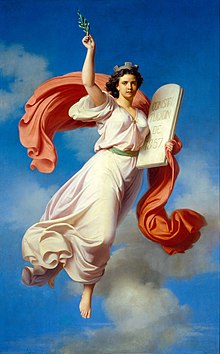
Back La Reforma Welsh Leyes de Reforma Spanish Lois de réforme French Reforma Dutch La Reforma (México) Portuguese
This article may lend undue weight to certain ideas, incidents, or controversies. The specific problem is: Contemporary and historical Mexican historiography is outweighed by English-language works. Additionally, not one source is from the 21st century. (October 2023) |

| History of Mexico |
|---|
 |
| Timeline |
|
|
In the history of Mexico, La Reforma (from Spanish: "The Reform"), or reform laws, refers to a pivotal set of laws, including a new constitution, that were enacted in the Second Federal Republic of Mexico during the 1850s after the Plan of Ayutla overthrew the dictatorship of Santa Anna. They were intended as modernizing measures: social, political, and economic, aimed at undermining the traditional power of the Catholic Church and the army. The reforms sought separation of church and state, equality before the law, and economic development. These anticlerical laws were enacted in the Second Mexican Republic between 1855 and 1863, during the governments of Juan Álvarez, Ignacio Comonfort and Benito Juárez. The laws also limited the ability of Catholic Church and Indigenous communities from collectively holding land. The liberal government sought the revenues from the disentailment of church property, which could fund the civil war against Mexican conservatives and to broaden the base of property ownership in Mexico and encouraging private enterprise. Several of them were raised to constitutional status by the constituent Congress that drafted the liberal Constitution of 1857. Although the laws had a major impact on the Catholic Church in Mexico, liberal proponents were not opposed to the church as a spiritual institution, but rather sought a secular state and a society not dominated by religion.[1]
The Juárez Law reduced the power that military and ecclesiastical courts held. The Lerdo Law forced land held in collective ownership to be sold to individual owners. It aimed at creating a dynamic real estate market, creating a class of yeoman farmers owning their own land, and raising revenue for the state. The measure was intended to strip the Church of most of its property, as well as to break Indigenous communities' collective ownership of land.
Both of these laws were later integrated into the Constitution of 1857, which also contained many other liberal reform measures. It was published on February of that year and was meant to come into power in September. The constitution allotted considerable power to Mexican states and well as giving Congress power over the President. Conservatives pushed back against the parts of the constitution that were perceived to infringe upon the rights of the church, and controversy was further inflamed when the government mandated that all civil servants take an oath to uphold the new constitution which left Catholic public servants with the choice of either keeping their jobs or being excommunicated.
In December, a section of the army under Félix Zuloaga rebelled under the Plan of Tacubaya. The controversy that had raged throughout the year convinced President Ignacio Comonfort to accept the plan, amounting to a self coup, which recognized him as president and increased his executive powers, believing that he could bring about a compromise between radical liberals and conservatives. When that failed, and the country began to plunge into civil war, he resigned, and the constitutional line of succession handed the presidency over to Benito Juárez, president of the Supreme Court. The War of the Reform broke out, lasting three years, between the liberal government under Benito Juárez and the conservative government under Zuloaga and others. During the war, Juárez outright nationalized most church properties in the states under his control. The war raged until December 1860, when the liberals emerged triumphant.
Almost immediately after the end of the war, Napoleon III used Juarez's suspension of foreign debts as a pretext to invade Mexico in 1862 and sought local help in setting up a client state. Seeing this as an opportunity to undo the Reform, conservative generals and statesmen joined the French and invited Habsburg archduke Maximilian to become Emperor of Mexico. Emperor Maximilian however, proved to be ideologically a liberal and actually ratified the Reform laws. Regardless, the government of Benito Juárez resisted, and fought the French and Mexican Imperial forces with the material and financial aid of the United States. The French withdrew, leading the monarchy to collapse in 1867. The liberals achieved a decisive victory, and the Constitution of 1857 would remain in force all throughout the dictatorship of Porfirio Diaz until he was overthrown by the Mexican Revolution, when the Constitution was replaced by the Constitution of 1917, which remains in force to this day.
- ^ Brian Hamnett, "Reform Laws" in Encyclopedia of Mexico, vol. 2, pp. 1239-1241. Chicago: Fitzroy Dearborn 1997.